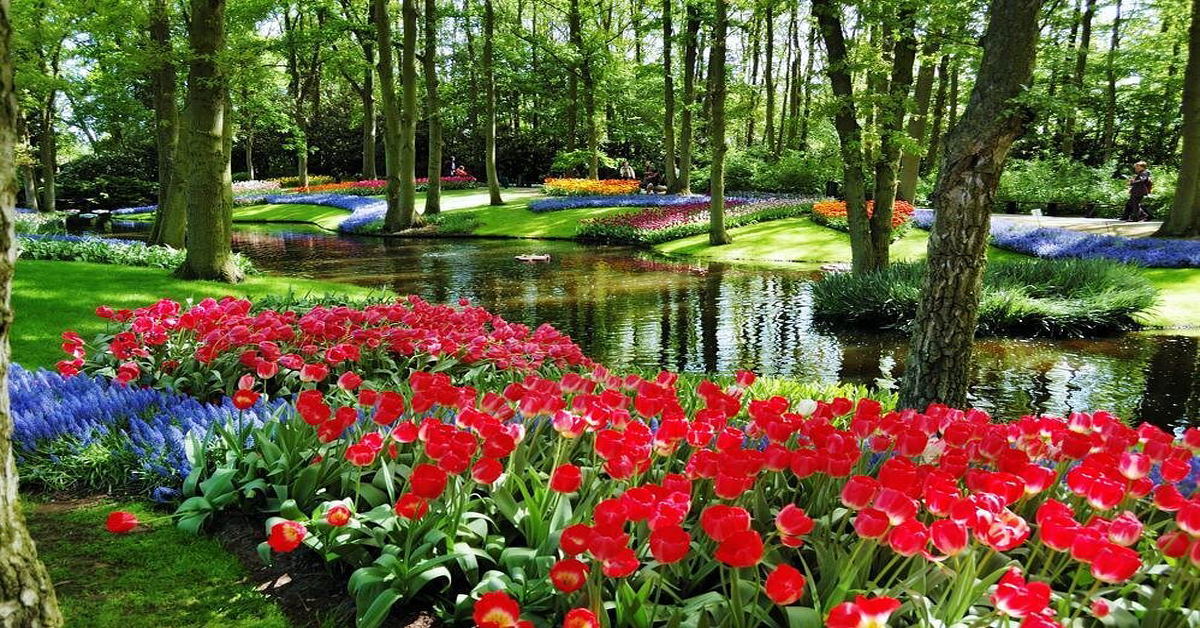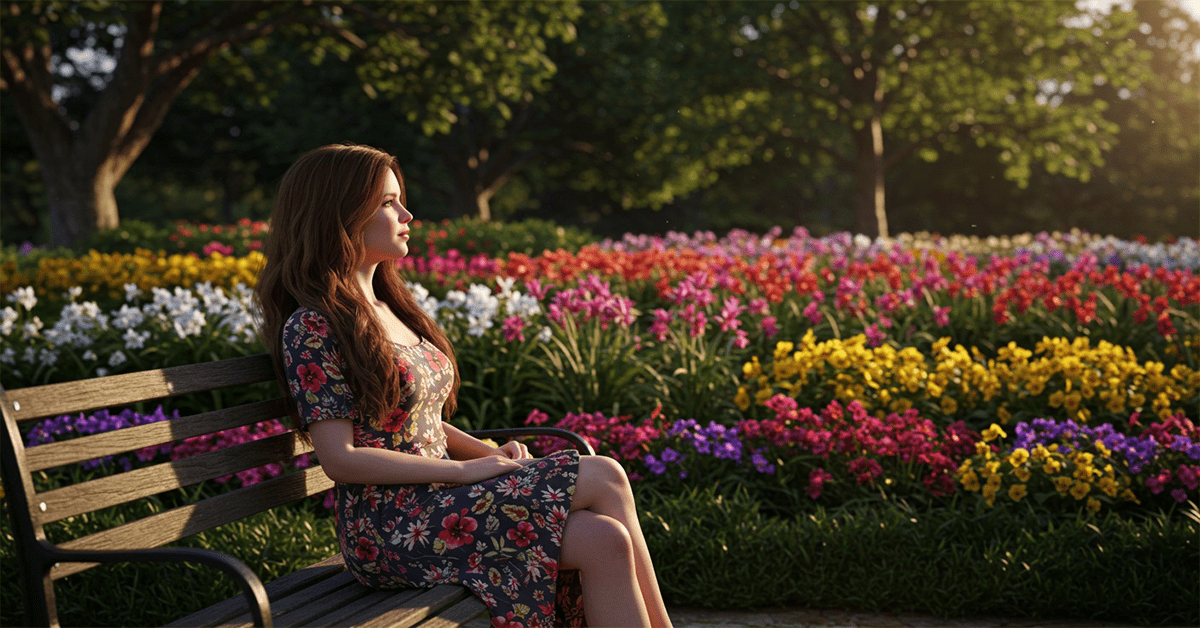What is Flower Viewing?
Flower viewing is more than simply admiring blossoms—it’s an immersive experience that connects people with nature, culture, and wellness. At its core, flower viewing involves visiting gardens, meadows, or festivals where flowers bloom in abundance. Whether it’s strolling under pink cherry blossoms, wandering through endless tulip fields, or smelling roses at a cultural fair, flower viewing offers a sensory escape from modern-day stress.
Unlike a casual walk in the park, floral tourism is intentional.
People travel specifically to witness seasonal blooms, sometimes crossing countries to catch a flower in its peak season. This makes flower viewing a unique intersection of tourism, cultural tradition, and holistic health. For centuries, humans have associated flowers with beauty, renewal, and peace. Science now backs these feelings, showing that flowers can reduce cortisol levels, improve mood, and even enhance memory retention.
The experience is both physical and emotional. Your body responds positively to fresh air, greenery, and floral aromas, while your mind benefits from the calming colors and rhythms of nature. In fact, psychologists have coined the term “flower therapy” to describe the healing effect of simply being around blossoms. This therapeutic connection explains why floral tourism is growing worldwide—not just as a hobby, but as a lifestyle choice for healthier living.
The Rising Popularity of Floral Tourism Globally
Floral tourism has transformed into a global travel trend, drawing millions of people every year to specific destinations. Japan’s cherry blossoms alone attract nearly 63 million visitors annually. The Netherlands becomes a sea of tourists every spring when the tulip fields burst into vibrant colors. Meanwhile, countries like Thailand, India, and the United States host grand flower festivals that merge tradition, art, and wellness.
Why is floral tourism booming? Firstly, social media plays a big role. Instagram and TikTok are filled with stunning flower fields that inspire travelers to experience the beauty firsthand. Secondly, wellness travel is on the rise—people are seeking mindful, eco-friendly experiences rather than crowded city escapes. The global wellness tourism market was valued at $814.6 billion in 2022 and is projected to reach $2.1 trillion by 2030, growing at a CAGR of 12.42%. This surge is fueled by travelers prioritizing mental, emotional, and physical well-being over traditional sightseeing.Flower viewing fits perfectly into this trend, combining natural beauty, physical activity, and cultural immersion.
Governments and tourism boards also recognise the economic potential of flower tourism, investing in large-scale flower shows and garden preservation projects. This trend isn’t slowing down anytime soon; instead, it’s becoming a global movement where travellers plan vacations around blooming seasons. The more the world embraces eco-tourism and mindfulness, the more flower viewing becomes a centrepiece of modern wellness travel.
Historical and Cultural Roots of Flower Viewing
Flower Viewing Traditions in Japan (Hanami)
When people think of flower viewing, Japan’s hanami is usually the first tradition that comes to mind. “Hanami,” meaning “flower viewing,” specifically refers to the centuries-old practice of gathering under cherry blossoms during spring. The custom began during the Nara period (710–794) when aristocrats wrote poems inspired by the fleeting beauty of sakura blossoms. Over time, it spread to the common people, becoming a beloved national tradition.
Today, hanami is more than just viewing flowers—it’s a social and cultural ritual. Families, friends, and co-workers gather under blooming cherry trees, sharing food, drinks, and music while appreciating the blossoms. This celebration symbolises renewal, hope, and the transient nature of life, as the flowers bloom briefly and fall quickly.
In Japanese philosophy, this impermanence is tied to the concept of mono no aware—a gentle awareness of life’s fleeting beauty.
Beyond cherry blossoms, Japan also celebrates plum blossoms (ume) and wisteria festivals, each with its own cultural significance. International travellers flock to Japan every spring to experience hanami, making it one of the world’s most recognised floral tourism events. The health benefits are undeniable, too—walking through the parks, breathing in crisp spring air, and enjoying moments of mindfulness beneath pink petals provide both physical refreshment and emotional healing.
If you’re planning to experience Japan’s magical cherry blossoms, joining a guided cherry blossom tour can take the stress out of navigating peak bloom times and crowded parks. Services like GetYourGuide
and Viator offer curated hanami tours that include picnic setups, cultural insights, and even evening illuminations. Booking in advance ensures you get the best spots to witness the blossoms while learning about the deep cultural traditions behind them.
European Floral Festivals and Garden Tours
Europe has its own deep-rooted traditions of floral appreciation. The Netherlands, famously known as the “flower shop of the world,” holds the Keukenhof Gardens exhibition, showcasing more than 7 million tulips, daffodils, and hyacinths.
The Dutch tulip season is short, and tickets to popular gardens like Keukenhof sell out fast. To make the most of your trip, consider booking a guided tulip field cycling tour or day trip through GetYourGuide.
or Viator. These tours often include transportation from Amsterdam, expert guides, and visits to both famous gardens and hidden local fields, giving you the complete Dutch flower experience.
In France, lavender fields in Provence attract thousands who not only admire the blossoms but also experience the calming effects of lavender aromatherapy.
In the UK, the Chelsea Flower Show is a global attraction, drawing horticulturists, artists, and wellness seekers alike. These events combine cultural pride with eco-consciousness, promoting both local tourism and environmental awareness. Many European cities also feature botanical gardens that serve as year-round hubs for floral tourism.
The tradition of admiring flowers in Europe has always been tied to art and literature. Writers, painters, and musicians often found inspiration in blooming gardens, highlighting the emotional and spiritual healing power of flowers. Today, these festivals are more than tourist attractions—they’re opportunities to reconnect with history, wellness, and beauty.
How Ancient Cultures Celebrated Nature’s Blossoms
Looking beyond Japan and Europe, ancient civilizations also celebrated flowers in various ways. Egyptians used lotus flowers in rituals symbolizing rebirth and purity. The Greeks associated roses and violets with gods and love stories, weaving them into their mythology. In India, marigolds have been integral to religious festivals for centuries, adorning temples and ceremonies as symbols of prosperity.
Many Indigenous cultures worldwide viewed flowers as sacred, incorporating them into healing rituals and ceremonies. For example, Native American tribes used wildflowers in medicine, storytelling, and seasonal celebrations. Across Asia, festivals like India’s Holi incorporate flowers as symbols of color, joy, and unity.
These traditions reveal a universal truth: flowers have always been more than decoration. They’ve been tools for healing, symbols of faith, and catalysts for social connection. By exploring floral tourism today, we’re not just seeking Instagram-worthy pictures—we’re reviving a timeless human practice of honoring nature’s blooms for health, wellness, and cultural meaning.
Physical Health Benefits of Flower Viewing
Boosting Immune Function Through Nature Exposure
When you immerse yourself in a field of flowers, you’re doing more than pleasing your eyes—you’re strengthening your immune system. Studies in environmental psychology and medicine show that exposure to natural environments, especially those rich in plant life, boosts immune function.
This is largely due to phytoncides—natural chemicals released by plants that enhance human immune activity. The research showed that phytoncide exposure also reduced stress hormone levels, which indirectly supports immune health by lowering cortisol and adrenaline.
Flower viewing often involves spending hours outdoors, which means you’re also soaking in vitamin D from sunlight. This vital nutrient strengthens bones, regulates mood, and supports the body’s defense system. Breathing in fresh air away from urban pollution further revitalizes the respiratory system.
Beyond that, simply walking through flower gardens improves cardiovascular health. It lowers cholesterol, enhances lung capacity, and encourages gentle but consistent physical activity. For elderly people and those recovering from illness, flower viewing provides a low-impact, highly beneficial way to stay active while boosting immunity.
The impact is so profound that some hospitals integrate “healing gardens” into their facilities. Patients surrounded by flowers recover faster, need less medication, and report higher well-being levels. This growing evidence positions floral tourism not only as a recreational activity but as a preventive healthcare practice.
Reducing Stress and Blood Pressure with Floral Scenery
Modern life is fast-paced and stressful, and prolonged stress contributes to high blood pressure, heart disease, and insomnia. Flower viewing acts as a natural stress reliever. Research from the University of Exeter found that people who spend time in green and floral environments report lower stress levels and improved mental clarity.
When you walk among flowers, your parasympathetic nervous system (responsible for relaxation) is activated. This leads to slower heart rates, reduced muscle tension, and lower blood pressure. Aromatic flowers like lavender and jasmine further enhance this effect by calming the nervous system and improving sleep quality.
The colors of flowers also play a role. Soft pinks, purples, and blues are known to reduce anxiety, while yellows and oranges elevate energy and optimism. Together, these natural cues create a harmonious environment that reduces stress while nurturing physical health.
Think of it this way: a day spent at a flower festival can offer the same stress-relief benefits as a meditation retreat, but in a much more vibrant and social setting. This explains why floral tourism is increasingly being recommended as part of wellness retreats and holistic healing programs worldwide.
The Role of Walking Tours in Enhancing Fitness
One of the overlooked health benefits of flower viewing is the physical exercise it naturally involves. Most floral destinations—whether cherry blossom trails, tulip fields, or botanical gardens—require walking long distances. While you may not think of it as a workout, strolling through these natural landscapes often results in several thousand steps per day.
Walking is one of the safest and most effective forms of exercise, particularly for people who struggle with high-impact workouts. It strengthens muscles, improves cardiovascular health, and boosts metabolism. When paired with the joy of flower viewing, walking feels effortless rather than forced.
Some floral tourism spots also offer hiking trails through mountainous flower valleys, combining the benefits of trekking with the serenity of flower therapy. These tours not only improve endurance but also enhance lung function by exposing visitors to clean, oxygen-rich air.
In short, flower viewing doubles as an enjoyable fitness routine. Instead of hitting the gym, travelers burn calories, strengthen their hearts, and refresh their minds—all while surrounded by nature’s beauty.
Mental and Emotional Wellness Benefits
Flowers as Natural Mood Enhancers
Have you ever noticed how receiving flowers instantly makes you smile? That’s not just a sentimental reaction—it’s a biological one. Flowers release scents and display colors that trigger the brain’s dopamine and serotonin pathways, which are responsible for feelings of happiness and relaxation.
When you’re surrounded by flowers, your senses are flooded with positive stimuli. The soft touch of petals, the bright array of colors, and the delicate fragrances all work together to uplift your spirits. This explains why flower viewing festivals are often described as “magical” experiences—our brains are wired to find joy in floral beauty.
Studies confirm that spending even a short time among flowers improves mood, reduces feelings of loneliness, and increases life satisfaction. For travelers battling work burnout or seasonal depression, flower viewing offers a natural and enjoyable form of therapy.
Another fascinating aspect is how flowers inspire optimism. Their blooming cycles remind us of resilience and renewal—no matter how harsh the winter, spring always returns with blossoms. This symbolism resonates deeply, making flower viewing not just a sensory delight but an emotional reset.
Combating Anxiety and Depression Through Nature Therapy
Anxiety and depression are some of the most common mental health struggles of modern life, often worsened by technology overload, urban living, and lack of contact with nature. Flower viewing offers a gentle, natural solution—what many researchers now call nature therapy or green therapy. Being surrounded by blossoms has been proven to calm the mind, lower cortisol (the stress hormone), and encourage mindfulness.
When you step into a garden or attend a flower festival, your focus naturally shifts from internal worries to external beauty. The repetitive patterns of petals, the symmetry of blooms, and the rhythmic swaying of flowers in the breeze help the brain enter a meditative state. This state quiets overthinking and reduces symptoms of anxiety.
In terms of depression, studies suggest that exposure to flowers significantly improves overall mood and feelings of hope. For instance, patients given flowers during hospital stays report reduced depression symptoms and faster recovery compared to those who weren’t. Flower viewing combines the uplifting presence of blooms with physical movement, social interaction, and time outdoors—all key factors in combatting depressive episodes.
What makes floral tourism especially powerful is that it turns healing into a shared, joyful event. Instead of therapy feeling clinical or isolating, it becomes a festival, a celebration, a moment of collective happiness under the blossoms. That transformation makes it easier for people to embrace healing without stigma.
The Power of Color Psychology in Floral Tourism
Colors are powerful communicators, and flowers—being some of the most colorful elements in nature—have a direct impact on our emotions. Psychologists have long studied color psychology and found that certain shades affect mood, behavior, and even energy levels. Floral tourism naturally incorporates this therapy by surrounding visitors with diverse palettes.
When tourists attend floral festivals, they’re not just enjoying pretty sights—they’re bathing in a spectrum of natural therapy. This explains why flower viewing is often described as visually nourishing—it feeds both the eyes and the emotions. In fact, some wellness retreats now combine floral tourism with guided color meditation sessions, enhancing the therapeutic benefits.
Social and Community Benefits of Flower Festivals
Building Community Connections Through Shared Experiences
One of the most beautiful aspects of flower viewing is how it brings people together. Festivals centered around flowers are rarely solitary events; they’re designed for gatherings, picnics, performances, and communal enjoyment. In Japan, hanami parties are an example of how blossoms unite families, co-workers, and even strangers in shared appreciation of fleeting beauty.
Community bonds grow stronger in these spaces. Neighbors who may rarely speak come together to celebrate local blooms. Tourists from around the world gather, sparking cultural exchange. Vendors, artists, and performers also participate, turning the festival into a platform for collaboration.
In this way, flower viewing becomes more than tourism—it transforms into a collective ritual that strengthens the social fabric. Shared laughter under the blossoms or collective awe at a floral display builds connections that go beyond the event. Researchers confirm that participating in community festivals increases feelings of belonging, trust, and social happiness—all essential for mental health.
Family Bonding and Relationship Strengthening
For families, flower festivals provide a unique opportunity to step away from screens and daily routines to spend quality time together. Parents often bring children to these events to teach them about nature’s beauty, cultural traditions, and the importance of seasonal change. Kids, in turn, develop a sense of wonder and mindfulness that strengthens their emotional development.
Couples also find floral tourism deeply romantic. Walking hand-in-hand beneath cherry blossoms or sharing moments in a tulip field often becomes a cherished memory. The symbolism of renewal and love tied to flowers adds extra depth to these experiences. Even friendships can grow stronger as groups travel together for flower viewing trips, turning the journey into a bonding adventure.
Psychologists note that shared joyful experiences—such as attending festivals—help people form stronger emotional connections. Thus, flower viewing isn’t just good for individual wellness but also for building healthier, happier relationships.
Festivals as Platforms for Cultural Exchange
Flower festivals are cultural windows where traditions, art, and history are proudly displayed. International travelers visiting these festivals often experience more than just flowers—they encounter local music, cuisine, fashion, and customs. For example, visitors to Thailand’s Flower Festival in Chiang Mai not only admire blossoms but also witness parades, traditional dances, and floral-themed costumes.
This cultural exchange fosters understanding between nations. Travelers learn about the symbolic meaning of flowers in different societies, from Japan’s cherry blossoms symbolizing impermanence to India’s marigolds representing prosperity. In turn, locals learn to appreciate the global interest in their traditions, leading to cultural pride and preservation.
Flower festivals often invite international participants as well, showcasing floral art from different regions. These events become bridges that connect people beyond language, proving that beauty is a universal language everyone understands.
Ecological and Environmental Benefits of Floral Tourism
Promoting Biodiversity Through Flower Conservation
Floral tourism doesn’t just benefit people—it also plays a role in protecting ecosystems. Many festivals and botanical gardens are tied to conservation efforts that preserve rare or endangered flower species. For example, orchid festivals often highlight the importance of saving these delicate flowers from extinction due to deforestation or overharvesting.
By attracting visitors, floral tourism generates revenue that is often reinvested into conservation projects. This includes maintaining natural reserves, protecting pollinators like bees and butterflies, and funding research on plant preservation. Tourists, in turn, become more aware of biodiversity and its importance to human survival.
Furthermore, by showcasing the value of flowers beyond decoration, these festivals emphasize the ecological role of blossoms in maintaining balanced ecosystems. Without flowers, pollination would decline, food chains would collapse, and biodiversity would shrink. Thus, flower viewing is not only a form of leisure but also an educational tool that inspires people to protect nature.
Sustainable Tourism Practices in Flower Destinations
To balance conservation with the growing popularity of floral tourism, many destinations are adopting sustainable practices. For instance:
Some regions also designate specific walking paths to protect flower fields from trampling. Others invest in digital tools that let visitors enjoy virtual previews, reducing pressure on sensitive areas.
The goal is clear: ensure that floral tourism thrives without damaging the very beauty that attracts visitors. By adopting sustainability, flower festivals prove that human enjoyment and nature preservation can coexist harmoniously.
Popular Flower Viewing Destinations Worldwide
Japan’s Cherry Blossom Trails
Japan remains the most iconic destination for flower viewing. Each spring, cherry blossoms (sakura) paint cities and countryside in shades of pink and white. From Tokyo’s Ueno Park to Kyoto’s Philosopher’s Path, travelers flock to enjoy hanami picnics beneath blooming trees.
The Japanese approach to cherry blossom viewing is not only about beauty but also mindfulness. The blossoms symbolize life’s fleeting nature, encouraging visitors to cherish the present moment. This philosophy makes the experience deeply spiritual for many.
Tourism during sakura season is booming, with entire cities hosting lantern-lit evening festivals, boat rides under blossoms, and traditional performances. For health, the combination of walking, social bonding, and meditative reflection makes cherry blossom tourism one of the most enriching flower-viewing experiences globally.
The Netherlands’ Tulip Fields
If cherry blossoms define Japan, tulips define the Netherlands. Every spring, the Dutch countryside transforms into a breathtaking rainbow of tulip fields stretching as far as the eye can see. The famous Keukenhof Gardens, often called the “Garden of Europe,” showcases over 7 million tulips and other spring flowers, making it one of the largest floral displays in the world.
Walking through these vast fields feels like stepping into a living painting. The rows of tulips—arranged in precise, colorful patterns—evoke a sense of joy and wonder that’s hard to replicate elsewhere. Beyond visual beauty, tulip viewing is deeply tied to Dutch history. Tulips sparked the world’s first economic bubble in the 1600s, known as “Tulip Mania,” and continue to be a symbol of national pride.
Health-wise, the experience combines gentle walking tours with fresh air and exposure to sunlight, helping visitors feel energized and rejuvenated. Local guides often share stories about tulip cultivation, enriching the experience with cultural knowledge. Festivals surrounding the tulip bloom also include parades, art shows, and cycling tours, giving travelers opportunities for both exercise and entertainment.
What makes tulip tourism especially impactful is its accessibility. Whether you’re visiting Keukenhof or cycling through small Dutch villages, tulip fields are everywhere in spring, inviting travelers to explore at their own pace. The blend of history, health, and beauty makes the Netherlands a floral tourism hotspot unlike any other.
Rose Festivals in the Middle East and Europe
Roses, often called the “queen of flowers,” are celebrated worldwide for their beauty and fragrance. In countries like Bulgaria, Morocco, and Turkey, rose festivals have become cultural landmarks that combine health benefits with rich traditions.
Bulgaria’s Rose Valley, for instance, hosts the annual Rose Festival in Kazanlak, where fields of Damask roses are harvested for essential oils. Visitors participate in rose-picking rituals, parades, and folk music performances. The air itself is filled with the calming scent of roses, which has been shown to reduce stress, promote relaxation, and even improve sleep quality.
In Morocco’s Kelaat M’Gouna, the Festival of Roses marks the spring harvest with music, dance, and traditional markets. Travelers can stroll through rose plantations, learn about rose water production, and enjoy aromatherapy directly from nature.
Europe also honors roses with festivals like France’s International Rose Competition in Lyon, where gardeners and botanists showcase innovative varieties. These events combine horticulture with cultural pride, attracting visitors from across the globe.
The beauty of rose festivals lies in their multi-sensory impact. Visitors don’t just see roses—they inhale their fragrance, taste rose-infused foods, and even take part in traditional ceremonies. This makes rose tourism a full-bodied wellness experience that nourishes both body and soul.
Flower Viewing as a Form of Eco-Therapy
The Concept of Eco-Healing
Eco-healing, also called eco-therapy, refers to using nature as a tool for physical and psychological recovery. Flower viewing is one of the most accessible and enjoyable forms of eco-healing because it engages multiple senses while providing restorative effects.
Spending time among blossoms reduces stress, lowers heart rates, and improves emotional well-being. Unlike clinical therapy, eco-healing feels natural and effortless—visitors heal without realizing they’re in “therapy.” The beauty of eco-healing is that it benefits everyone, from children to seniors, regardless of cultural background.
Modern research shows that eco-therapy boosts mental clarity, encourages emotional resilience, and helps with conditions such as PTSD, anxiety, and chronic fatigue. Flower viewing adds a layer of symbolism—blooms represent renewal, growth, and hope, which inspires visitors to adopt healthier, more mindful lifestyles.
How Floral Tourism Encourages Mindful Living
Mindfulness—the practice of living fully in the present—has become a cornerstone of modern wellness. Flower viewing naturally nurtures mindfulness. When you walk through a blooming garden, your senses are engaged: you notice the details of each petal, the scent carried by the breeze, the way sunlight filters through blossoms.
This sensory immersion grounds you in the moment, breaking the cycle of overthinking and distraction. Unlike forced meditation practices, mindfulness during flower viewing happens spontaneously, making it accessible to everyone.
Travelers often describe floral tourism as “soul-soothing” because it reminds them to slow down. The fleeting nature of blossoms also emphasizes the importance of cherishing life’s small moments. This gentle lesson in mindfulness makes flower viewing both a leisure activity and a transformative life practice.
Case Studies of Healing Through Flower Viewing
Several studies and real-life examples highlight the healing power of flower viewing:
These examples confirm that flower viewing is not just about beauty—it’s about holistic healing. Whether on a personal or community level, blossoms have the power to restore balance, health, and happiness.
Economic Impact of Floral Tourism
Boosting Local Economies Through Seasonal Tourism
Flower tourism is more than a wellness trend—it’s a thriving economic engine. When flowers bloom, entire towns and regions see a surge in tourism revenue. Hotels, restaurants, transportation services, and local shops benefit from the influx of visitors who come specifically for flower-related events.
In Japan, cherry blossom tourism contributes billions of yen annually to the economy. Similarly, the Netherlands’ tulip festivals generate millions in ticket sales, guided tours, and exports of flower bulbs. Smaller communities also thrive—farmers open their fields to tourists, artisans sell flower-inspired crafts, and local food vendors profit from increased foot traffic.
What makes floral tourism unique is its predictability. Unlike random tourist trends, flower seasons are cyclical, ensuring steady annual income for communities. This reliability allows regions to plan infrastructure improvements, promote local businesses, and invest in cultural preservation.
Flower Festivals as Global Attractions
Flower festivals have evolved into global events that attract international tourists. The Pasadena Rose Parade in the United States, Chiang Mai Flower Festival in Thailand, and Floriade in Australia are just a few examples of festivals that draw global attention.
These festivals often go beyond flowers, showcasing parades, music, dance, and gastronomy, turning them into cultural extravaganzas. As global attractions, they not only boost tourism revenue but also enhance international visibility for host regions.
For health-conscious travelers, these festivals double as wellness retreats. They combine cultural immersion with the therapeutic benefits of flower viewing, making them highly appealing in the age of wellness tourism.
Creating Job Opportunities in Rural Areas
Floral tourism creates employment opportunities, especially in rural and agricultural regions where flower cultivation is prominent. Farmers benefit from both direct sales (like flower bulbs or essential oils) and tourism services (like guided tours and farm stays).
Seasonal workers find jobs in event management, hospitality, and transportation during peak bloom seasons. Local artisans and food vendors also profit from increased exposure to international tourists.
This economic ripple effect helps sustain rural economies, reducing urban migration by providing stable income sources in small communities. Floral tourism proves that beauty doesn’t just heal individuals—it strengthens economies and sustains livelihoods.
Planning a Flower Viewing Trip
Best Times of the Year for Floral Tourism
Timing is everything when it comes to flower viewing. Since most blooms are seasonal, planning ahead ensures you catch flowers at their peak.
Travelers should also consider local weather, crowd levels, and festival schedules when planning their trips. Some destinations offer quieter alternatives outside the main tourist season, making the experience more peaceful.
Essential Tips for First-Time Visitors
If you’re planning your first flower-viewing trip, preparation can make the difference between a rushed visit and a deeply fulfilling experience. Here are some practical tips to ensure you make the most of your journey:
For first-timers, it’s easy to get overwhelmed by the excitement and beauty. But by slowing down and following these tips, your trip becomes more than sightseeing—it becomes a mindful and memorable journey.
Safety and Health Precautions
While flower viewing is generally safe, there are a few health precautions to keep in mind:
By planning carefully, you can avoid discomfort and enjoy the health benefits that floral tourism offers. After all, the goal of flower viewing is relaxation and rejuvenation—not stress or health risks.
Role of Technology in Modern Floral Tourism
Virtual Flower Viewing Experiences
In the digital age, even flowers have gone online. Virtual flower-viewing platforms now allow people to enjoy blossoms from the comfort of their homes.
Virtual tours may not replace the sensory experience of being there, but they still provide relaxation and visual pleasure. They also make flower viewing accessible to those with mobility challenges, limited budgets, or geographic restrictions. Some platforms even integrate VR (virtual reality) and AR (augmented reality), letting users “walk” through gardens virtually.
This technological adaptation is a game-changer—it democratizes access to flower viewing while also reducing environmental pressure on over-visited sites. For some, virtual experiences serve as a teaser that inspires them to plan real-life visits in the future.
Photography and Social Media Influence
Photography is central to modern floral tourism. Instagram, Pinterest, and TikTok are filled with breathtaking flower shots, inspiring millions to travel to famous bloom destinations. Social media has, in many ways, amplified the popularity of floral tourism, turning once-local festivals into global sensations.
While some criticize this trend as superficial, it actually plays an important role in wellness. Sharing floral photos encourages others to connect with nature, while the act of photographing flowers itself promotes mindfulness. Capturing the details of petals, light, and landscapes requires focus, which brings calm and awareness.
Social media also helps promote sustainability when used responsibly. Many eco-conscious travelers use their platforms to advocate for responsible tourism, reminding audiences to respect nature and avoid damaging delicate environments.
Online Flower Festival Communities
Beyond photography, digital platforms have given rise to global communities of flower enthusiasts. Online forums, Facebook groups, and festival websites allow people to share experiences, travel tips, and cultural insights.
For instance, cherry blossom fan groups share real-time updates on bloom forecasts across Japan, helping travelers plan their trips more effectively. Tulip enthusiasts exchange tips on the best cycling routes through the Dutch countryside. These communities foster connection and knowledge-sharing, even among people who may never meet in person.
This blend of technology and tradition ensures that flower viewing continues to grow—not just as a physical activity, but as a shared global culture that bridges digital and natural worlds.
Personal Growth Through Flower Viewing
Developing Patience and Mindfulness
One of the greatest life lessons flowers teach us is patience. Unlike instant entertainment, flowers bloom on their own schedule. Tourists often wait months—or even years—for the chance to see specific blossoms in their prime. This process encourages patience, reminding us that the best things in life often require waiting.
While waiting, travelers learn to be present in the moment. Watching blossoms sway in the wind, noticing subtle changes each day, or appreciating the fragility of petals promotes mindfulness. This practice carries over into daily life, helping individuals manage stress and stay grounded in their routines.
In a world obsessed with speed and productivity, flower viewing offers a rare invitation to slow down. It nurtures a mindset of gratitude and appreciation for small joys, which is essential for emotional resilience.
Inspiring Creativity Through Floral Beauty
Flowers have always inspired creativity, from Van Gogh’s sunflowers to modern floral photography. For artists, writers, and musicians, flower viewing provides a wellspring of ideas. The diversity of shapes, colors, and textures sparks imagination and encourages creative expression.
Even non-artists benefit. Travelers often find themselves journaling, sketching, or experimenting with photography after visiting flower festivals. Businesses also use floral tourism as inspiration for design, fashion, and culinary creations. For example, rose-infused pastries or lavender-flavored teas often emerge from festival experiences.
The act of engaging with flowers creatively also has therapeutic benefits. Art therapy combined with flower viewing amplifies relaxation and emotional release, making it a powerful tool for personal growth.
Spiritual Connections with Nature
Many cultures view flowers as sacred, and modern floral tourism often rekindles this spiritual connection. For some, walking through a field of blossoms feels like entering a natural temple. The beauty and fragility of flowers remind us of life’s impermanence, encouraging reflection on deeper meanings of existence.
Spiritual traditions often tie flowers to renewal, purity, and divine presence. In Buddhism, cherry blossoms symbolize mindfulness and impermanence. In Hinduism, marigolds are offered to gods as symbols of devotion. Christian traditions also use lilies as metaphors for purity and resurrection.
For travelers, connecting with these symbolic meanings during festivals adds a profound dimension to the experience. Beyond physical and emotional healing, flower viewing becomes a spiritual journey—one that nourishes both soul and body.
Challenges and Criticisms of Floral Tourism
Overcrowding and Environmental Damage
As floral tourism grows, so do concerns about sustainability. Popular destinations like Japan’s cherry blossom parks or the Netherlands’ tulip fields often face overcrowding, leading to trampling of flowers, littering, and strain on local infrastructure.
Overcrowding diminishes the peacefulness that flower viewing is meant to provide. Instead of mindfulness and relaxation, visitors may experience stress from large crowds. Moreover, fragile ecosystems are at risk when too many people walk through delicate fields.
To address this, destinations are implementing crowd control measures such as timed entries, ticket reservations, and designated pathways. However, balancing popularity with preservation remains a major challenge.
Commercialization of Natural Beauty
Another criticism is the commercialization of floral tourism. While festivals boost local economies, some argue that excessive commercialization—through merchandise, ticket sales, and luxury tourism packages—distracts from the authentic experience of connecting with nature.
In some cases, flowers are grown primarily for tourism rather than natural preservation, raising ethical concerns about resource use and sustainability. Critics worry that flower festivals may prioritize profit over ecology, turning sacred cultural traditions into tourist spectacles.
Still, many organizers are finding ways to balance cultural authenticity with tourism needs, ensuring that commercialization doesn’t overshadow the essence of flower viewing.
Balancing Conservation with Tourism Growth
Perhaps the biggest challenge is finding harmony between conservation and tourism. Flowers are delicate, seasonal, and vulnerable to environmental changes. Too much tourism can harm the very beauty people come to see.
Solutions include promoting lesser-known destinations to spread out visitor impact, investing in digital experiences, and educating tourists on responsible behavior. Conservation-focused tourism ensures that flowers remain a source of beauty, healing, and cultural pride for generations to come.
The Future of Flower Viewing and Floral Tourism
Innovations in Sustainable Festival Management
As awareness of sustainability grows, flower festivals are embracing eco-friendly innovations. Some use solar power for lighting displays, while others recycle water for irrigation. Digital ticketing systems reduce paper waste, and organizers are increasingly partnering with environmental groups to promote conservation.
Future festivals may integrate smart technology, such as apps that provide real-time bloom updates, crowd density information, and eco-friendly travel tips. These innovations will make flower viewing more efficient, enjoyable, and sustainable.
Expansion of Floral Tourism to New Regions
While Japan, the Netherlands, and France dominate floral tourism, other regions are emerging as new hotspots. South Africa’s wildflower blooms, Australia’s desert flowers, and India’s Himalayan rhododendrons are gaining international attention.
As travel becomes more globalized, these lesser-known destinations will attract visitors seeking unique and less-crowded flower experiences. This expansion not only diversifies tourism but also spreads economic benefits to underrepresented regions.
Integrating Wellness Tourism with Flower Viewing
The future of floral tourism is closely tied to wellness. Travelers are increasingly seeking holistic experiences that combine relaxation, health, and cultural immersion. Flower viewing fits perfectly into this trend.
Expect to see more festivals partnering with yoga retreats, meditation programs, and eco-therapy workshops. Floral tourism will no longer be just about sightseeing—it will evolve into a complete wellness package, offering healing for the body, mind, and spirit.
Conclusion
Flower viewing and floral tourism are far more than seasonal spectacles. They are experiences that nourish health, strengthen communities, boost economies, and protect the environment. From Japan’s cherry blossoms to Morocco’s rose festivals, flowers unite people in celebration, mindfulness, and healing.
The health benefits are undeniable—reduced stress, improved immunity, enhanced creativity, and deeper emotional connections. But beyond health, floral tourism also nurtures cultural pride, ecological awareness, and spiritual growth.
As the world seeks more meaningful, sustainable, and mindful travel experiences, flower viewing will continue to bloom as a powerful force in global tourism. Whether you travel far or simply visit a local garden, flowers remind us of life’s fleeting beauty and the joy of living in the present.





